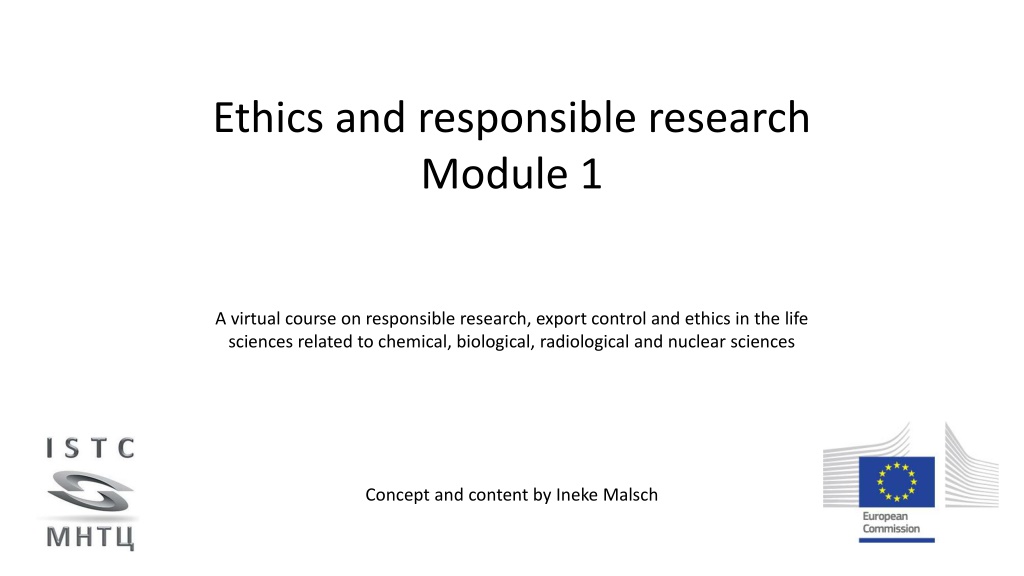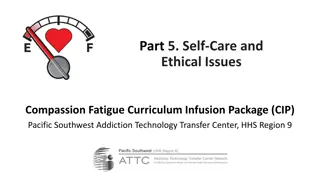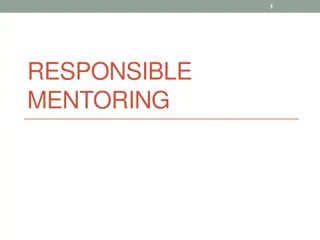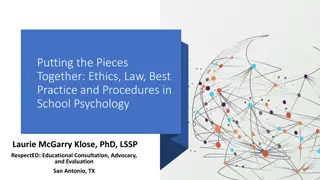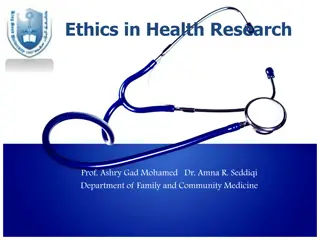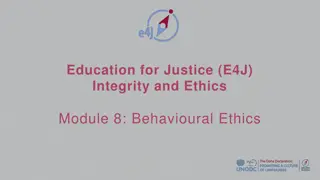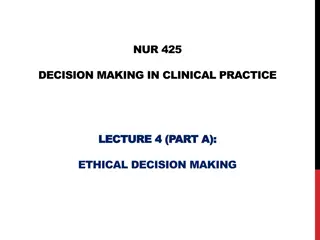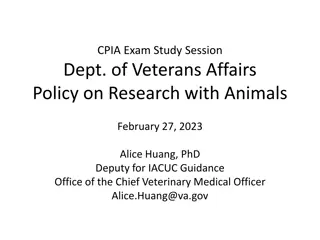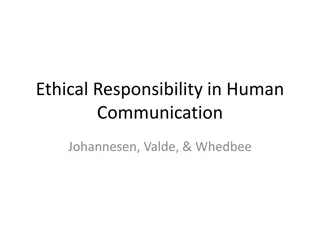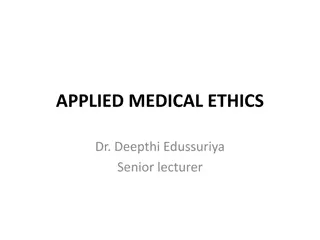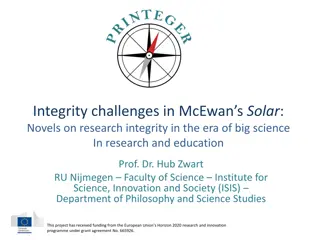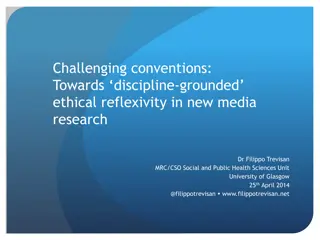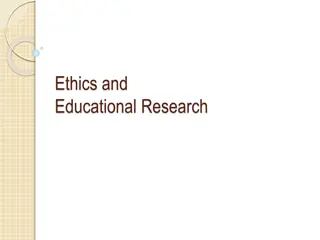Ethical Research and Responsible Science Course Overview
This virtual course delves into responsible research, export control, and ethics in the life sciences, specifically focusing on chemical, biological, radiological, and nuclear sciences. Developed by Ineke Malsch, the course covers core ethical concepts, conceptions of technology, and responsibilities in scientific endeavors. The content emphasizes the importance of ethical considerations and aims to equip researchers with a deeper understanding of ethical and professional dilemmas.
Download Presentation

Please find below an Image/Link to download the presentation.
The content on the website is provided AS IS for your information and personal use only. It may not be sold, licensed, or shared on other websites without obtaining consent from the author. Download presentation by click this link. If you encounter any issues during the download, it is possible that the publisher has removed the file from their server.
E N D
Presentation Transcript
Ethics and responsible research Module 1 A virtual course on responsible research, export control and ethics in the life sciences related to chemical, biological, radiological and nuclear sciences Concept and content by Ineke Malsch
Acknowledgements This virtual course on responsible research, export control and ethics in the life sciences related to chemical, biological, radiological and nuclear sciences has been produced and prepared for the International Science and Technology Center (ISTC) as part of the EU funded Targeted Initiative on CBRN Export Control on Dual-Use Materials and Intangible Technologies. The support of the European Commission for this course does not constitute endorsement of the contents which reflects the views only of the authors. The content of the course was created by Ineke Malsch. The project team of the Targeted Initiative on CBRN Export Control on Dual-Use Materials and Intangible Technologies provided comments and editing of the material.
Module 1 Core Concepts Introduction Core Concepts This course provides researchers the opportunity to reflect on responsible life sciences and dual use issues. By following this course, we hope you to gain an understanding that: (a) ethical considerations are relevant to your work, (b) are necessary, (c) are in your own interest This first module gives an overview of core ethical concepts. These concepts will be used in later modules for addressing the special role of scientists and discussing ethical and professional dilemmas. Selected references to online literature or videos are also included in the notes and in the annotated reading list for further study.
Module 1 Core Concepts Conceptions of technology There are many different conceptions of technology, from a simple thing to more sophisticated constructs including societal, political, legal, and social aspects. Research and development often result in new technologies, including products, processes, and systems. Natural and social scientists, industrialists, policy makers and citizens perceive these resulting technologies differently Some believe technologies are the neutral fruit of applying universal scientific methods Others consider technologies useful tools serving societal or economic goal Yet others perceive technologies as unnatural and suspicious The potential safety and security risks of technology are viewed differently by risk embracing and risk averse individuals and societies
Module 1 Core Concepts Responsibility Traditionally, governments are responsible for protecting the rights and security of their citizens and their territory In daily life, citizens have individual responsibilities for taking care of themselves and others, and for complying with regulations Science and technology escape this traditional division of responsibilities because they introduce uncertain and unforeseen risks which are not governed by existing legislation The transformation from the traditional governmental responsibility to collective responsibility is also known as the move from top-down government to collaborative governance of science and technology. Therefore, science and technology call for new forms of collective responsibilities, with role responsibilities allocated to governments, scientists, industry, civil society organisations and citizens
Module 1 Core Concepts Responsibility for science and technology Approach: What does it mean? Traditional division of labour: Science takes the credit for penicillin, while society takes the blame for the Bomb (Jerry Ravetz, 1975) Responsible Research and Innovation: Scientists and all stakeholders should imagine and discuss ethical and societal aspects of new technologies and, together, change course early In the early stages of innovation, the technology is flexible, but potential future impacts are unclear In late stages of innovation, the impacts are known, but the technology is entrenched and inflexible Collingridge Dilemma (1980):
Module 1 Core Concepts Responsible Research and Innovation (RRI) Under the flag of RRI, governments funding R&D demand co-responsibility for societal impacts from: Scientific community, research organisations and individual scientists Large industry and Small and Medium Enterprises engaged in R&D and innovation (in publicly funded projects) Civil society organisations including trade unions, environmental, consumer, peace movements
Module 1 Core Concepts Responsible Research and Innovation (RRI) The concept Responsible Research and Innovation comprises guidelines for taking this responsibility Several definitions are used, but all stress the need for the four elements listed below Element of RRI: What does it mean? Inclusiveness All people have the right to participate in science and reap the benefits Anticipation Reflect on potential future impacts on society and the environment already during the research phase Openness Publish results of scientific research and communicate about it to all people in understandable terms Responsiveness Engage in public dialogue with citizens and stakeholders and take their views into account in research strategies
Module 1 Core Concepts Responsible Research and Innovation (RRI) How can scientists and engineers take more responsibility for ethical and societal impacts of research? The funder s perspective: Six keys: What does it mean? Example: RRI is a horizontal priority in the R&D programme of the European Union All project proposals should address these six keys All proposals which are selected for EU funding go through ethics review Public engagement Projects funded by the EU must include (two-way) communication with stakeholders and citizens about results. Gender equality Equal participation of men and women in management and research, addressing gender-specific issues in the research. Science education Include training and education of young scientists, engage with schools or science museums. Open access / open science Publish results in open access publications, offer open access of research data, etc. Ethics Explore and address ethical issues of the research. Governance Contribute to responsible governance and policy making of science and technology (this is mainly addressed to policy makers).
Module 1 Core Concepts Dual use and Web of prevention dual use refers to the tangible and intangible features of technologies that enable them to be applied to both hostile and peaceful ends different final products share some (but only some) of the same technologies and knowledge within their production processes e.g. machine tools for bicycles and sewing machines, and modern biotechnology for vaccines and biological weapons, etc. Policies that disrupt the acquisition and exploitation of dual use technologies have the potential to generate substantial social costs Dual-use Dilemma often called The web of prevention is a collective term for the inter-linking and overlapping measures, customs, practices, laws, norms, codes, and regulations by governments, academia, industry and other stakeholders increasing the likelihood that misuse is detected in time, before harm is done
Module 1 Core Concepts Web of prevention and dual use Web of prevention The concept web of prevention emphasizes that different layers of governance and responsibility on various levels from local to international. Here, we focus on the contributions of scientists, while stressing the need for collaboration with governments, industry, and civil society organisations. Scientists can contribute by developing local solutions, for example: voluntary codes of conduct to regulate issues which are not covered by legislation. Special roles of scientists Engage with policy makers and engage with the general public by communicating findings and research. Technological solutions may include adapting the design of dual use applications.
Module 1 Core Concepts Research ethics Like other professions, researchers have specific ethical guidelines governing their work Research Ethics Research integrity Discipline-specific research ethics Societal responsibility Codes of conduct are formulated to guide ethical behaviour in research Transparency, plagiarism, reporting etc. Biomedical, ICT, engineering, etc. Responsible Research and Innovation, Codes, etc. This will be taken up in module 2
Module 1 Core Concepts Ethical, Legal and Societal Aspects (or Social Issues) of emerging technologies (ELSA) Example 1: In the USA, in 1990 the Human Genome project included a programme investigating Ethical, Legal and Social Issues One systematic approach is called Ethical, Legal and Societal Aspects (ELSA), sometimes called Ethical, Legal and Social Issues/Implications (ELSI) ELSA research is embedded in interdisciplinary research programmes, allowing to remediate possible risks while promoting potential societal benefits while the technology is still under development ELSA approaches rely on a division of labour where ethical, legal and social aspects of research are addressed in a systematic transdisciplinary way. Example 2: In the EU, from 2005 in national and European nanotechnology programmes incorporated Ethical, Legal and Societal Aspects research Potential solutions include regulatory (laws, codes of conduct), technological (value sensitive design) as well as social (dialogue, engagement) measures In contrast, in Responsible Research and Innovation, scientists and other stakeholders are expected to consider ethical and societal issues in their own work and contribute actively to a collective solution.
Module 1 Core Concepts The precautionary principle The precautionary principle is a core principle in the international discussion on responsible governance of emerging technologies in early stages of the development of the technology. Even though many stakeholders and governments agree that a precautionary approach is useful, there is no consensus on the definition or implementation. Two authoritative definitions are: The European Union (2000): The precautionary principle applies where scientific evidence is insufficient, inconclusive or uncertain and preliminary scientific evaluation indicates that there are reasonable grounds for concern that the potentially dangerous effects on the environment, human, animal or plant health may be inconsistent with the high level of protection chosen by the EU . The Rio Declaration (1992): In order to protect the environment, the precautionary approach shall be widely applied by States according to their capabilities. Where there are threats of serious or irreversible damage, lack of full scientific certainty shall not be used as a reason for postponing cost-effective measures to prevent environmental degradation .
Module 1 Core Concepts Conclusions - Recap In this module, several concepts were introduced, which will be used in this course Technology is perceived differently by different stakeholders in society The dual use dilemma complicates the design of measures to suppress misuse whilst promoting innovation and societal benefits Individual and collective responsibilities are distinguished, and two approaches to organising collective responsibility for the impacts of research and technology are briefly described (RRI and ELSA) Ethical concepts and international law aiming to prevent or misuse are outlined, and their relevance to technologies explained
Module 1 Core Concepts Exploring Core Concepts Self-assessment quiz: 1. Why were the core ethical concepts introduced in this module? a. To spark my interest in studying philosophy b. To improve my ability to work in life sciences research c. To raise my awareness that ethical concepts are open to interpretation 2. Who should take responsibility for the impacts of dual use life sciences on society? a. Government agencies b. Scientists c. Industry d. All above 3. Ethical considerations are a. a basis for restrictions on research in life sciences with dual use potential b. the foundation for discussions on the appropriate way to balance rights of scientists and other stakeholders, individuals and communities c. reinforcing the freedom of academic research
Module 1 Core Concepts Exploring Core Concepts Answers self-assessment quiz: 1: c. While general interest in philosophy and building capacity to do research in life sciences would be beneficial outcomes, the aim of this module is to raise awareness of ethical concepts and that they are open to interpretation, requiring discussion on the appropriate interpretation in each particular case. 2: d. Because the potential benefits and risks of life science research are complicated, the collaboration of all stakeholders (including the public) is needed for responsible governance of the resulting technologies. 3: b. Because there are contradictions between different rights, and appropriate trade-offs must be found in each case.
